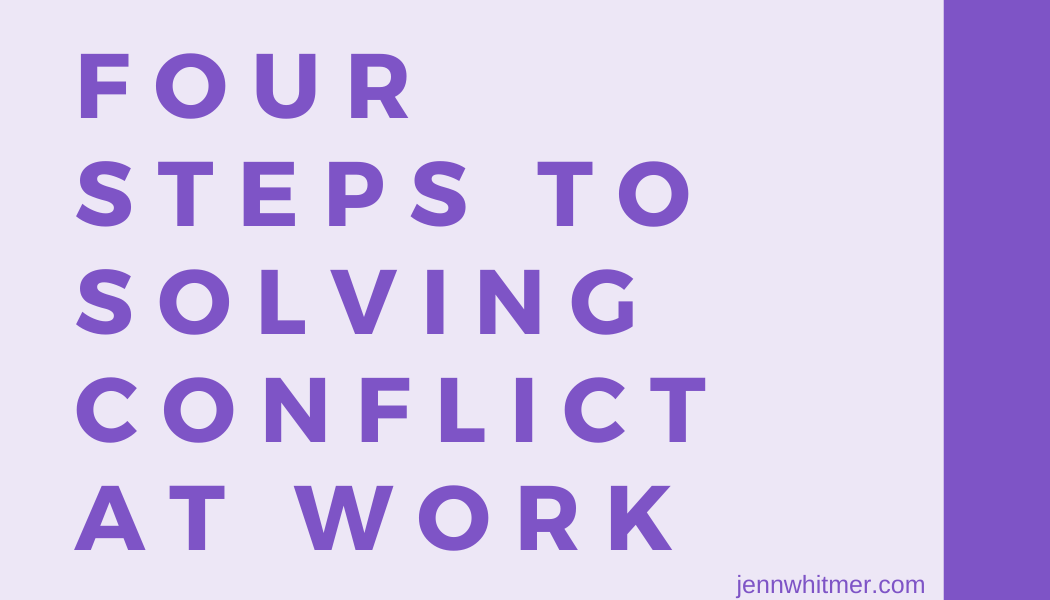We spend a lot of waking hours with people at work. About three hours a week are spent in workplace conflict. I mean that’s almost half a day! That’s a lot of lost time and productivity. Not to mention a lack of peace in a place where we spend so much of our lives.
Conflict at work is a special brand of difficulty—the nuances of fear and disappointment take on different significance when your livelihood is involved.
So what do we do with workplace conflict?
Whether you’re the newest associate or the CEO, these are four steps everyone can take in resolving workplace conflict.
Face it.
Conflict does not disappear like the fine morning mist. Often it mildews and grows worse.
Be proactive. Decide if this is an issue that is causing problems in productivity, breaks relationships, or is a pattern.
Then face it—literally face to face. Go to the person involved. Set a meeting and take the time to sit down across a table, or at least a video feed if you work remotely. Disagreements are best had face-to-face.
Listen—for real.
Take some time to ask questions, and — here’s the sticky wicket — actually listen for the answers! Don’t just wait for your turn to talk. Every day we make thousands of assumptions. You may discover in your listening an entirely different point of view that changes your struggle.
While listening, you may even take some notes to help you focus.
>>Sidenote: ask first about taking notes! I made that mistake one time, and the person clammed up. I wanted to make sure I understood what was being said, and the other person thought I was court-reporting. No worries, all good now. But let me save you that angst!<<
Some questions to ask:
- What are your thoughts about this situation?
- How do you feel about this?
- What are some reasons you see it that way?
- What do you want to do about this?
Reflect back what you’re hearing:
- So what I hear you saying is…
- Can I share with you what I understand about what you’re saying?
Share your concern. Use “I-statements” that let you express your issue in a professional manner.
Say: I felt ____ when ____ happened because ____.
Go for the root.
Find out what you’re really talking about. Popping off dandelion heads just gets more dandelions.
Sometimes the problem is a system or just a mistake. It can be a cross-cultural misunderstanding. The vast majority of the time, it’s unclear expectations and fuzzy purpose.
Take responsibility, ask for forgiveness, and apologize for your part in the issue as appropriate. Even if your role is just confusion!
Together look at the root of the issue.
Ask: How can we work together to solve this problem?
Communicate and check back.
Once you’ve discovered the problem and created a solution, write down the plan. You think you’ll remember, but it’s highly unlikely you’ll remember all the parts. Ever been to the grocery and come home without the thing you went for because you forgot the list?! That’s the point. Write it down.
Then communicate to everyone involved. Sometimes that’s just the two people. Sometimes there are others to bring in. Clearly communicate the next steps and people responsible.
Set a time to check back in. And this is where lots of people just let things slide away.
People say, “You can always come to me.” But that awkwardness can be hard to overcome! So set a time in the future to check the progress. Gauge the check-in against the intensity of the conflict. It may take weekly check-ins for the next quarter. It may be a simple as 10 minutes over coffee in a month.
For those of us who don’t need closure, this can feel unproductive. Yet, over and over again, this check-in builds trust and makes an opportunity for faster conflict resolution, and just less conflict, in the future.
Find this helpful? Share with your friends!
Have questions? Drop them in the comments below. ⏬
Want some more personal help? Contact me for a coaching session.
Does your team need this? Contact me in for a team training.Source: Workplace Conflict Statistic

COMMENTs:
0